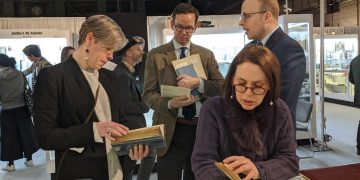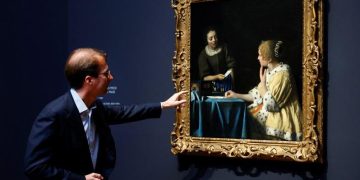Richard Branson, the British billionaire and founder of Virgin Group, has always been synonymous with adventure and breaking boundaries. From founding Virgin Records to pioneering space tourism through Virgin Galactic, Branson’s career has been marked by a relentless drive to explore uncharted territories. However, alongside his commercial and entrepreneurial successes, Branson has quietly amassed an extraordinary collection of space memorabilia and adventure gear—items that reflect his deep connection to the world of exploration, innovation, and human ambition.
His private collection, which includes pieces from the history of space exploration, as well as equipment used in his own personal adventures, has become a focal point for elite collectors and scholars alike. This collection offers not only a rare look into Branson’s personal journey but also serves as a treasure trove of historical artifacts that reflect humanity’s push into space and the unknown.
In this article, we will explore why Richard Branson’s private space and adventure collection has captivated the attention of collectors and historians, and why it stands as a vital link between commercial space travel and the history of human exploration.
1. A Personal Connection to Space Exploration
Richard Branson’s connection to space goes beyond mere interest; it’s personal. His company, Virgin Galactic, has become one of the key players in the emerging field of commercial space travel. The idea of privatizing space exploration was a dream of Branson’s long before the first commercial space flights began. As the founder of Virgin Galactic, Branson has taken part in several space-related ventures, and many of the items in his collection reflect his own involvement in this groundbreaking industry.
For example, Branson’s collection includes artifacts from Virgin Galactic’s test flights, pieces of spacecraft used during their groundbreaking missions, and personal gear used by astronauts in the early days of private space travel. These items are not only valuable for their technical and historical significance, but they also represent Branson’s vision for the future of space exploration—a future in which civilians, not just astronauts, could visit the stars.
The personal nature of Branson’s collection adds an extra layer of intrigue. Unlike other collectors, who may simply seek to acquire space-related artifacts, Branson’s collection is a direct extension of his own life’s work. The collection tells a story of passion, vision, and innovation.
Key Takeaway: Richard Branson’s collection is unique because it combines historical space artifacts with items tied directly to his own personal and entrepreneurial journey. It represents his ongoing commitment to the development of commercial space travel.
2. Historical Significance: A Link to the Space Race
Space exploration is not only a modern phenomenon but also a defining chapter in human history. Branson’s collection includes items that trace the history of the Space Race—the period during the Cold War when the United States and the Soviet Union competed for dominance in space exploration. Among the most coveted pieces in his collection are artifacts from NASA’s Apollo missions, including artifacts from the iconic Apollo 11 mission that landed the first humans on the Moon.
These objects hold immense historical value. The Apollo program, which culminated in the 1969 Moon landing, was a monumental achievement in human exploration. Branson’s collection includes original pieces from NASA’s space missions, like parts of space suits, mission patches, and flight manuals, which are important not just for their connection to a particular mission, but for their role in shaping the modern space race and human understanding of space.
Scholars and historians are drawn to Branson’s collection because it provides a tangible link to these pioneering moments in history. For researchers, having access to such items helps illuminate the stories of the astronauts, engineers, and visionaries who made space exploration possible. Moreover, these artifacts help track the progress of space exploration, from government-funded missions to private ventures like Virgin Galactic.
Key Takeaway: Branson’s collection offers a firsthand look at the legacy of space exploration. The inclusion of Apollo-era artifacts gives historians valuable material for understanding the Space Race and its significance in the development of modern space programs.
3. The Evolution of Space Travel: From Government to Commercial
One of the most compelling aspects of Richard Branson’s collection is its role as a bridge between traditional government-funded space exploration and the future of commercial space travel. Branson’s efforts to democratize space through Virgin Galactic represent a seismic shift in the space industry, and his collection captures this evolution.
In Branson’s collection, you can find items from both the early, government-led space missions and the newer, privately funded ones. These include objects from the Mercury and Gemini programs, early astronaut training equipment, and various experimental spacecraft that were precursors to today’s commercial space vehicles. By juxtaposing these items with memorabilia from modern private companies, such as the SpaceX Falcon 9 rocket, Branson’s collection highlights the growth and transformation of space travel from a government monopoly to an increasingly privatized venture.
This collection has become a critical resource for scholars and industry leaders alike, who look to it as a roadmap for the future of space exploration. Branson’s vision, as reflected in the artifacts he collects, points to a future where commercial enterprises are central to humanity’s continued exploration of space.
Key Takeaway: Richard Branson’s collection highlights the transition from government-led space programs to commercial space ventures. It captures the spirit of innovation and entrepreneurialism that is shaping the future of space travel.
4. Adventure and Innovation: The Spirit of Exploration
Branson’s collection isn’t limited to space memorabilia; it also includes equipment related to his many other adventures. As a seasoned adventurer, Branson has taken part in several record-breaking feats, such as attempting to circumnavigate the globe in a hot air balloon and making daring voyages across the Atlantic and Pacific Oceans in a boat. The equipment and gear associated with these expeditions—whether it’s a high-altitude balloon, a specially designed aircraft, or even a wetsuit worn during an ocean crossing—are integral to Branson’s adventurous spirit and his drive to explore uncharted territories.
These items, often seen as tools for personal achievement, are also symbolic of the broader human pursuit of discovery and innovation. They represent the same ideals that drive space exploration: pushing boundaries, embracing the unknown, and seeking new frontiers. As such, Branson’s collection is not only a tribute to the future of space exploration but also to the spirit of adventure that has defined his life.
Historians and collectors are particularly interested in these artifacts because they represent more than just personal milestones—they are a reflection of a larger cultural movement towards exploration and risk-taking. They embody the human instinct to venture beyond the familiar, whether that means traveling to space or navigating the most dangerous corners of the Earth.
Key Takeaway: Branson’s adventure gear is a reflection of his broader philosophy of pushing boundaries and embracing risk. These artifacts resonate with collectors and historians because they capture the spirit of exploration that has driven human progress throughout history.

5. The Future of Space Tourism: A New Chapter in Human History
Richard Branson’s most significant contribution to space exploration may well be his pioneering work in space tourism. Virgin Galactic’s mission to make space travel accessible to civilians represents a new chapter in human history, and Branson’s collection has become a key part of this narrative. As the first commercial space flights take off, the artifacts Branson has collected will serve as important historical markers for future generations.
Branson’s involvement in Virgin Galactic places his collection at the intersection of history and innovation. Items from the company’s test flights, including cockpit instruments, flight suits worn by the first civilian astronauts, and even the spacecraft itself, are a testament to Branson’s vision for making space travel a reality for everyday people. These objects will eventually become symbols of humanity’s democratization of space, serving as milestones for both collectors and historians.
As space tourism becomes more mainstream, Branson’s collection will likely grow in importance, with many viewing it as a time capsule for the era of private space exploration. Collectors will continue to value these items not only for their historical significance but also for their role in shaping the future of human exploration beyond Earth.
Key Takeaway: Branson’s collection is a key historical resource for understanding the birth of commercial space tourism. As the industry grows, his artifacts will become invaluable markers of a new era in space exploration.
6. The Role of Branson’s Collection in Shaping Public Perception
The items in Branson’s collection are not only valuable to historians and collectors—they also play a significant role in shaping the public’s perception of space exploration. Branson has long been an advocate for the idea that space should be accessible to everyone, not just government astronauts. His collection, particularly the pieces associated with Virgin Galactic, is a testament to this vision and helps illustrate the democratization of space.
By showcasing his collection to the public, Branson encourages interest and excitement in space exploration. He allows ordinary people to engage with the history of space travel and feel connected to the idea that they, too, could one day venture into space. As a result, his collection is an important tool for building public enthusiasm for the future of space tourism.
Key Takeaway: Branson’s collection also serves as a tool for shaping public interest in space travel. By making these artifacts accessible, he encourages the public to embrace the idea of space as a reachable frontier for everyone.
Conclusion
Richard Branson’s private collection of space memorabilia and adventure gear has become much more than just a collection of objects—it is a bridge between the past, present, and future of human exploration. From historic space artifacts that trace the legacy of space exploration to items linked to Branson’s own groundbreaking ventures in commercial space tourism, his collection offers a unique and comprehensive view of the evolution of space travel and human adventure.
For collectors, historians, and industry professionals, Branson’s collection serves as a valuable resource, providing insight into the journey of human exploration, the development of private space ventures, and the broader cultural movement toward adventure and risk-taking. As space tourism grows and becomes more accessible, the items in Branson’s collection will continue to hold immense value, not just as historical relics, but as symbols of humanity’s unwavering drive to reach for the stars.


















































